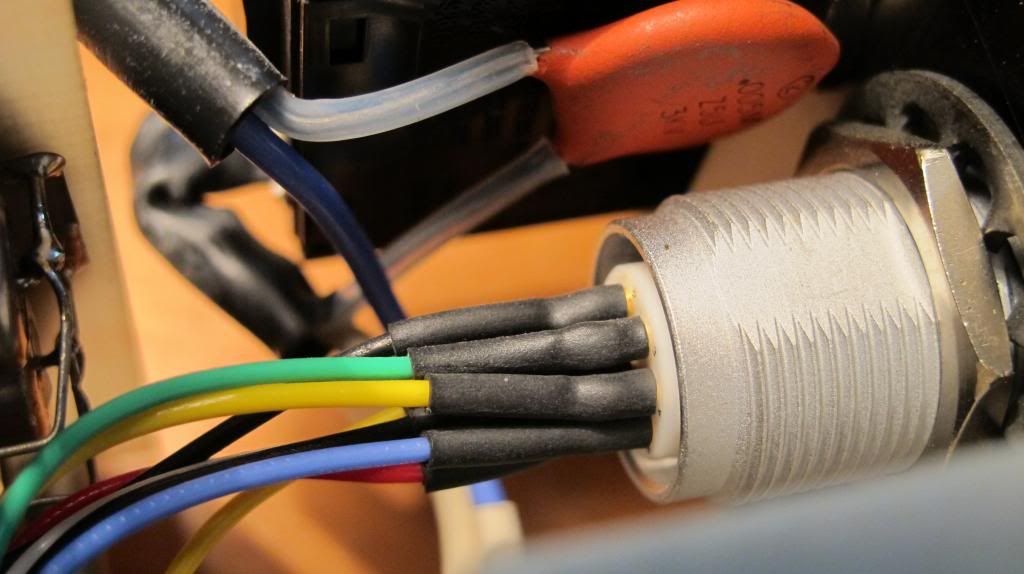I am soldering an 8 PIN DIN and I noticed these wire connectors on the jack- Seems would be a lot easier to use these on the DIN connection instead of trying to solder 8 wires on my tiny DIN connector... What are these wire connectors called? and where can I buy them? I am using 22 Gauge wire I assume they crimp or solder??


I need to pull a wire and look I guess- Could what I seek be these?
22 22 18 Gauge Wire Solderless Butt Splice Connector Insulated Molded Sleeve | eBay
22 22 18 Gauge Wire Solderless Butt Splice Connector Insulated Molded Sleeve | eBay
I'm with Harleyjon, I think that's just shrink sleeve over soldered connections.
Agreed...that is the way I'd do it.
Do these connectors exist? I have never done such detailed soldering and I think I would do a better job with a connector then just push it on the pin- Please look at my last post and link - are these them?
A butt splice is just that: to splice two wires together...not what you need.
Look up heat shrink tubing.
To be put on the wire (away from soldering heat) and then pushed over the soldered connection and shrunk with a heat gun.
What you cannot see in the pix is what is under the heat shrink.
If you want to practice then just use two pieces of wire and then heat shrink the solder joint after.
Youtube probably has vids of these processes.
Have fun.
Look up heat shrink tubing.
To be put on the wire (away from soldering heat) and then pushed over the soldered connection and shrunk with a heat gun.
What you cannot see in the pix is what is under the heat shrink.
If you want to practice then just use two pieces of wire and then heat shrink the solder joint after.
Youtube probably has vids of these processes.
Have fun.
I guess I was thinking of these Audioquest Headshell Leads because I use them for connecting the wires to the back of audio cartridges and the one's I have at home should fit on this DIN connector- I know they sell these separate from the wire and you solder the wire on and then slip it on the pin- It might work well for a DIN connector- I am familiar with using heat shrink- I have just never seen it so small- any idea where I can buy heat shrink for 22 gauge wire?
I know where I can buy it...locally, but that does not help you because I don't know where you are located.
Digi-Key or Mouser or Newark should all have it.
Digi-Key or Mouser or Newark should all have it.
There are a couple ways to do this, as mentioned above. The photo really really looks like plain old soldered connections with a piece of heat shrink tubing covering it. And that is neat and secure.
If the connector had little pins sticking out for connectors to push onto, as you seem to imply, it would be terrible unreliable.
There are many connectors that come as an empty connector body, and the pins come loose in bulk. Each wire gets a little bit of insulation stripped off the end then a pin is crimped onto the wire end, then the pin it inserted INTO, not onto, the connector body. This describes a lot of the "Molex" type connectors.
Crimp on connections are good, but they snap into the body of the connector and would not as a rule have heat shrink tubing over them, like your photo shows.
If the connector had little pins sticking out for connectors to push onto, as you seem to imply, it would be terrible unreliable.
There are many connectors that come as an empty connector body, and the pins come loose in bulk. Each wire gets a little bit of insulation stripped off the end then a pin is crimped onto the wire end, then the pin it inserted INTO, not onto, the connector body. This describes a lot of the "Molex" type connectors.
Crimp on connections are good, but they snap into the body of the connector and would not as a rule have heat shrink tubing over them, like your photo shows.
- Status
- Not open for further replies.
- Home
- Design & Build
- Parts
- Help please- Need to ID a wire connector